Tea
Caddy Index

History of
caddies
Tea and Opium
Request
current list of available tea
caddies.
| |
Important brassbound Rosewood writing box with complex secrets by Thomas Lund with Bramah lock Circa 1819
Please click on images to enlarge | slide show | thumbnail
index |
Reference: WB429
Description:
WB429: Important Regency brass edged and inlaid writing box with double layered secret compartments and drawers, by Thomas Lund of
Cornhill, a replacement leather writing surface and compartments for pens and stationery. The secret compartments include a rare sprung false bottom.
The box retains original cut 19th c inkwells and keys for both the main Bramah lock and the separately locked writing flap. Circa 1820.
Origin: UK Thomas Lund
56 and 57 Cornhill, London
Circa: 1820.
Materials: Rosewood
inlaid with brass on a mahogany construction.
Size: 50.5cm by 28.7cm by 19cm: 19.8 inches by 11.3 inches by
7.5 inches.
Condition: Very
good overall: see images; working locks and keys.
|
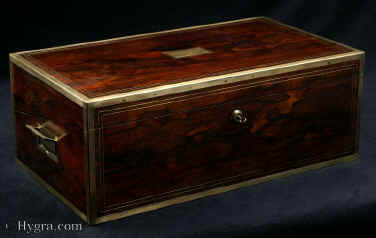
|
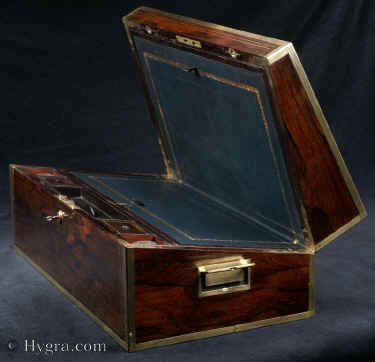
|
This was a time of industrial
innovation and the Bramah lock was part of that innovation. They
were made to the highest specification and gave a great improvement on
security. Joseph Bramah took out his patent for the
Bramah Lock in 1784.
The entry for Thomas Lund in the Dictionary
of English Furniture Makers, 1660-1840 reads:
"Lund, Thomas,
56 and 57 Cornhill, London, portable desk manufacturer, cutler
and dressing case maker (1819-39), In 1819 declared himself to
be a 'cutler, manufacturer of portable desks, pens
&quills, importer of filtering stones'. Two tortoise-shell
tea caddies are known marked with this makers stamp. One with
a domed rectangular lid and ivory feet is marked 'Lund, Maker,
57 Cornhill London' and the other an octagonal one, is stamped
on the inside ivory rim 'LUND CORNHILL ST"
|
|
Please click on images to enlarge | slide show | thumbnail
index |
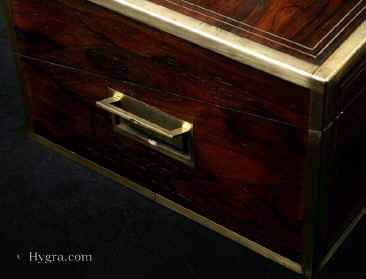
|
The rosewood is saw cut and
highly figured. There are inset brass carrying handles on both
sides.
The brass edging is held in
place by brass pins driven in at an angle. The edging contrasts
with the rich colour of the rosewood and also gives protection from
knocks. The use of brass which was both structural and decorative.
was highly fashionable in the Regency period.
|
| LUND Thomas,
56 and 57 Cornhill, London, produced work of
high quality, straddling the period between the Regency and the Victorian
period.
Boxes from Thomas Lund seem to have a special quality which has a
refinement without over elaboration. The interiors of their boxes are
meticulously finished, with the fabrics (when used) coordinated with
flair. Everything opens and shuts well.
Below are listed some other boxes by Thomas Lund we have handled:
1. Quality writing box veneered in rosewood and inlaid with
brass stringing. Thomas Lund. C. 1825.
2. Fine sewing box veneered in rosewood, brass stringing. Silk
covered interior.Thomas.C.1825.
3. Dressing box veneered in coromandel with rounded brass
surround and two thin lines of stringing. Side drawer for jewelry has
silk cover. Interior fitted with velvet and gold tooled leather. Nicely
engraved silver tops on the bottles by Francis Douglas, London 1841.
Thomas. Another almost identical box with maker's name on brass plaque.
5. Coromandel veneered sewing box with fine inlay in brass and
mother of pearl. Thomas.
| http://hygra.com/uk/sb/SB121 |
|
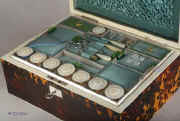
Please click on image
or link for detailed webpage.
|
ref
SB121:
A rare fully fitted tortoiseshell sewing box of rectangular form
and shaped top by Thos' Lund of Cornhill, having ivory facings,
silvered hinges and lock, mother of pearl escutcheon and name
plate engraved "Mrs. Brown". Inside there is a liftout
tray with green and blue silk coverings and supplementary lids
containing turned and carved mother of pearl spools (8) and other
sewing tools. The inside the lid is covered in ruched blue silk
framed with a smooth silk border and contains a document wallet in
the lid. Circa 1820.
|
|
The rosewood is beautifully
figured on all sides. The front and the top have further inlaid brass
lines.
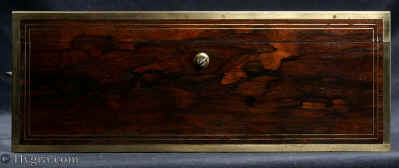
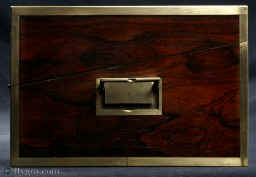
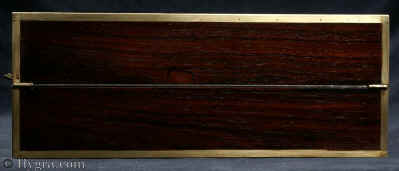
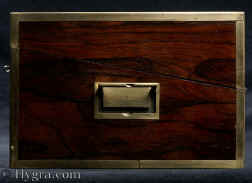
|
Please click on images to enlarge| slide show | thumbnail
index |
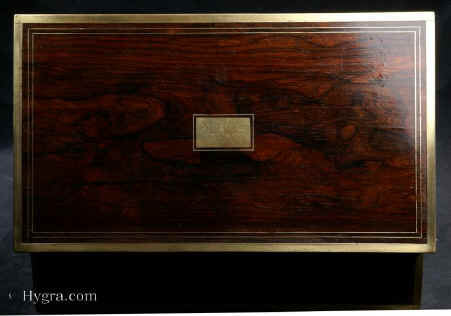
|
The centre of the the top has an engraved inlaid name plate:
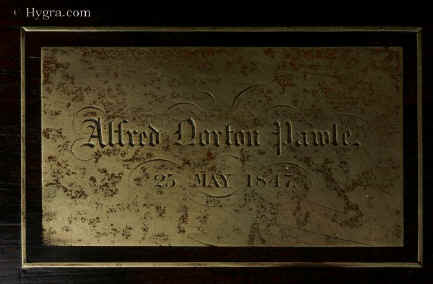
It reads: "Alfred Norton Pawle. 25th May 1847".
1847 is later than the date of manufacture. Both the style of the box
and the form and marking of the Bramah lock point to about 1820. It was
quite normal for important boxes to be passed from one generation to the
next..
|
Please click on images to enlarge| slide show
| thumbnail
index |
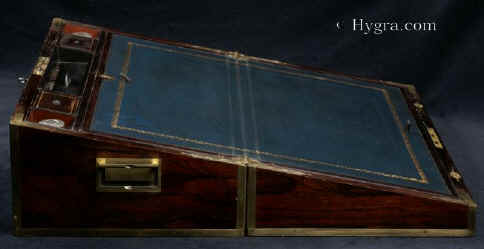
|
The embossed
writing surface is a repacement.
|
Please click on images to enlarge| slide show
| thumbnail
index |
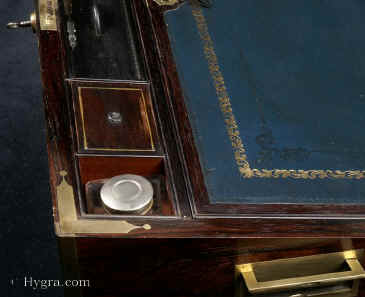
|
There are further brass
inlays to the facings and the supplementary lids. The liftout pen tray
is of dovetail construction is made from solid ebony.
The corner detail with the inlay to the facings is similar
to: http://hygra.com/uk/wb/wb116/
|
The box has two original 19th C keys. The Bramah key is
for the main lock the other, simpler key locks the flap.
|
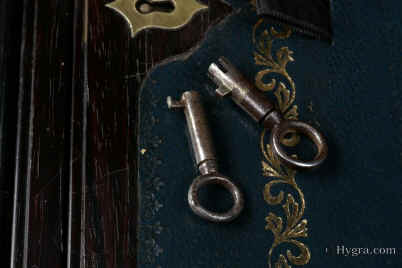
|
The box retains
original cut 19th c inkwells.
These are mid 19th C matching
the date of the engraving to the plaque in the top.
|
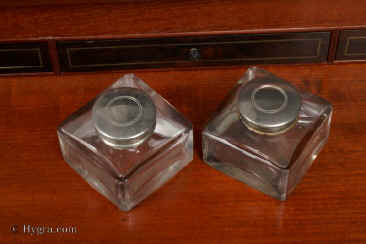
|
Please click on images to enlarge| slide show | thumbnail
index |
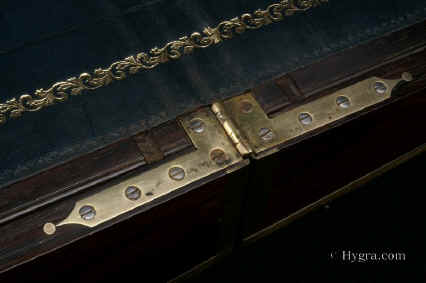
|
Detail of the elaborate strap hinging. Note the slots of the screws
are all lined up in the same direction..
The third screw from the left
is not what it appears to be. It is in fact the release button for the
false bottom.
|
Please click on images to enlarge| slide show | thumbnail
index |
Please click on images to enlarge| slide show
| thumbnail
index |
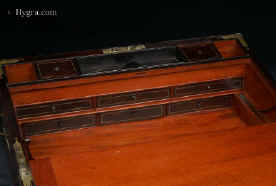
|
The box has three sprung
panels concealing six drawers and a compartment.
When all three sprung panels
have been removed the box has six secret drawers which are of dovetail
construction and faced with rosewood inlaid with a brass line. The pulls
are turned ebony.
|
The
Bramah lock is in working order. The lock plate is marked J.
Bramah 124 Piccadilly and the symbol of a crown.
Joseph Bramah took out his patent for the
Bramah Lock in 1784.
For further information on
Bramah locks:
www.hygra.com/locks/Bramah/index.htm
|
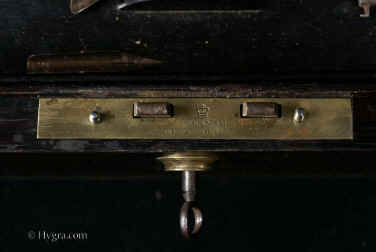
|
Please click on images to enlarge| slide show | thumbnail
index |
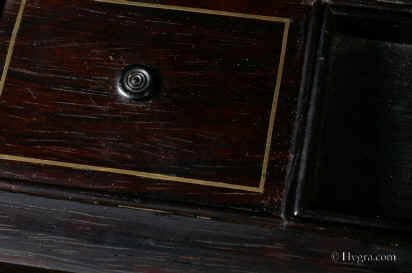
|
Detail: The supplementary lids are veneered with rosewood and
have turned ebony pulls.
|
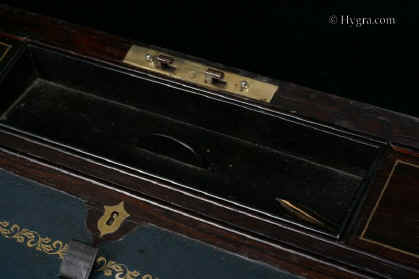
|
The Liftout pen tray is crafted from solid ebony.
|
Please click on images to enlarge| slide show
| thumbnail
index |
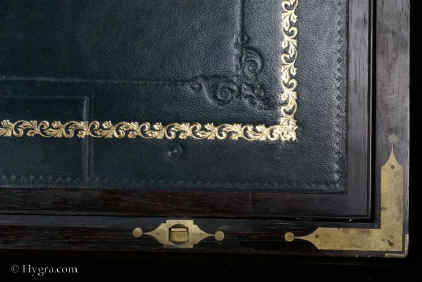
|
The embossed leather writing
surface is a replacement.
|
The inside of the box is
finished with a thin coat of shellac. The webbing, for posting important
documents, which need attention on the back of the flap is original. a
small section of the webbing has been lost.
|
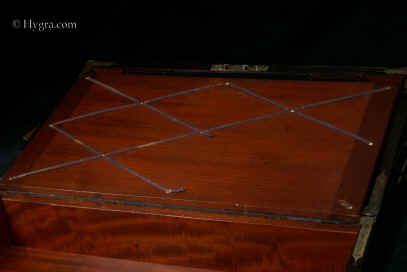
|
Please click on images to enlarge| slide show
| thumbnail
index |
The other flap has a separate
lock. It retains its original key.
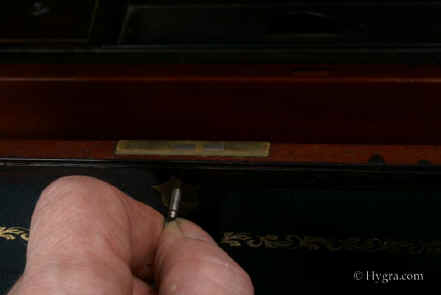
|
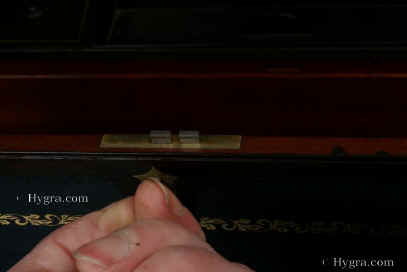
|
Please click on images to enlarge| slide show
| thumbnail
index |
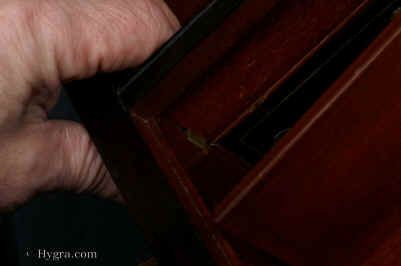
|
Accessing the Secrets
The secret drawers are concealed behind sprung panels of solid
mahogany.
The first panel is released by taking out the inkwell and squeezing
the wall of the box between the thumb and index finger.
|
The center of the panel is embossed:" LUND MAKER CORNHILL"
|
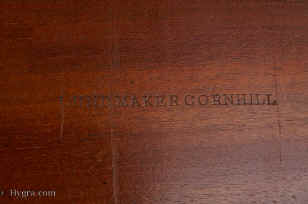
|
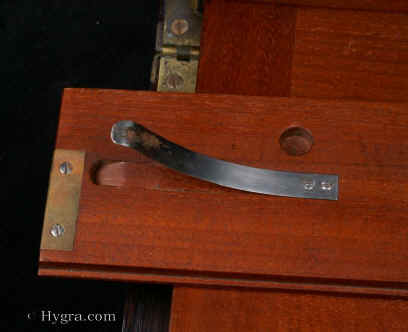
|
Detail of the back of the panel. once again the screws
are lined up! The hole is to accommodate the pull handle of one of
the secret drawers.
|
Please click on images to enlarge| slide show
| thumbnail
index |
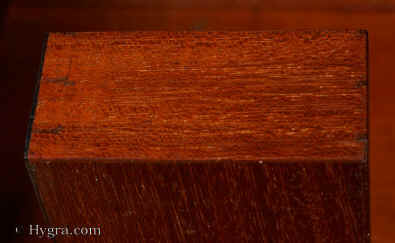
|
The drawers are of dovetail
construction. The craftsmanship is impeccable. All the surfaces
have a fine sealing coat of shellac.
|
The fronts of the
drawers are veneered with rosewood and have turned ebony pulls as well
as being inlaid with a brass line.
|
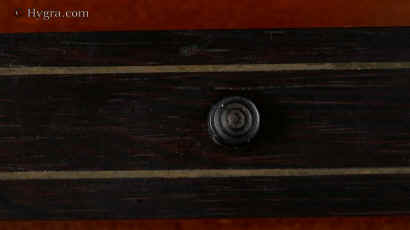
|
The divisions between the drawers have a molded bead run in.
This gives a lighter look while retaining the strength of construction.
|
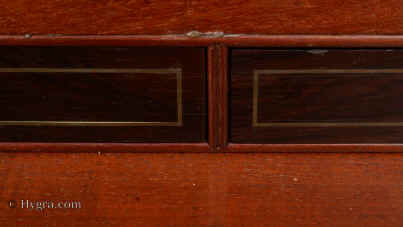
|
Please click on images to enlarge| slide show
| thumbnail
index |
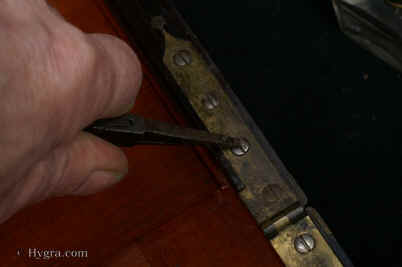
|
The entire bottom of the main compartment conceals further
secrets.
The bottom is a sprung panel. It is held in place by a catch on both
sides. The catches are released by pressing on the screws as shown in
the photo on the left and below.
|
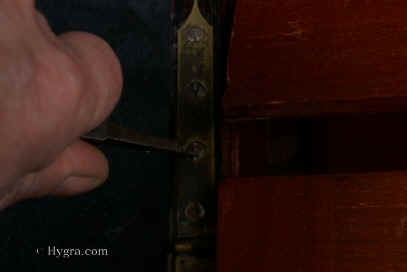
|
This is the box when all three panels have been taken out.
The secret drawers are concealed by two panels one above and the
other below the false bottom..

|
Please click on images to enlarge| slide show
| thumbnail
index |
Beneath the panel which covers most of the bottom of the box
there is a further nest of three drawers concealed by a further panel.
This is released by pressing the wood of the side just below the spring.
|
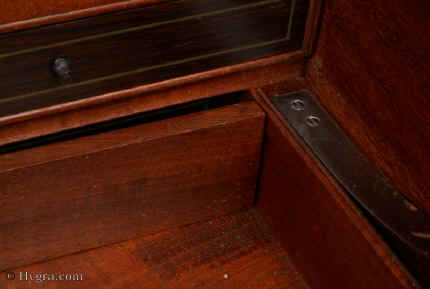
|
Please click on images to enlarge| slide show | thumbnail
index |
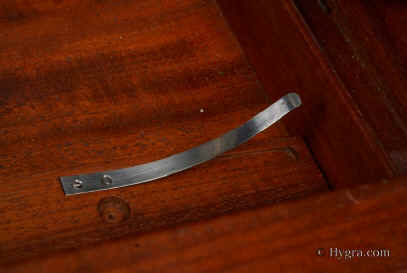
|
Detail: the reverse of the
lower panel.
|
The inside of the box is impeccably finished. Even the surface
of the wood which would never be seen unless the drawers were taken out completely,
as here, are polished
|
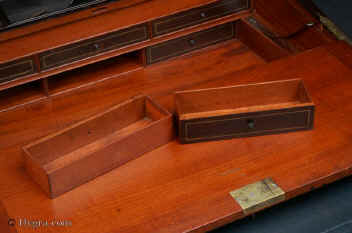
|
| The drawers are constructed using finely cut dovetail
joints. |
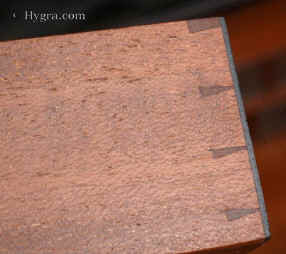
|
Please click on images to enlarge| slide show
| thumbnail
index |
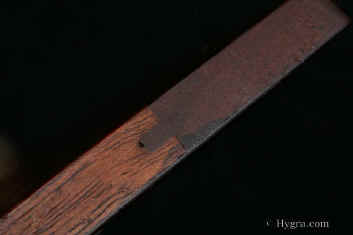
|
Detail showing the construction of the writing flaps. The flaps
have a main central piece of wood flanked by two further pieces of wood.
They are joined using a tongue and groove joint shown in the photo. on
the upper surface
|
Please click on images to enlarge| slide show
| thumbnail
index |
Request
current list of available writing boxes.
News
| Buying
| email | Online
History of boxes | The
Schiffer Book |
All text and images and linked images are ©
1999-2009 Antigone Clarke and Joseph O'Kelly. If you require any further
information on permitted use, or a licence to republish any material, email us
at copyright@hygra.com
|